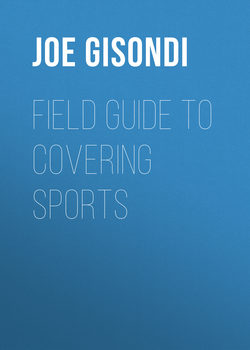Читать книгу Field Guide to Covering Sports - Joe Gisondi - Страница 42
На сайте Литреса книга снята с продажи.
Prepare
ОглавлениеYou’ll need to develop new information, not just rehash what others have published or said. To find a fresh angle, you’ll have to determine what’s already been written about a person, team, or topic. Check websites set up by the teams themselves, along with those produced by news organizations and by individual players. In addition, read newspaper and magazine stories and check blogs related to these topics. Don’t forget to check social media to determine what’s new and what’s old. Eventually, you’ll have several potential angles or story ideas.
Sports Illustrated senior writer Lee Jenkins, who has written more than 100 features and 30 cover stories for the magazine, says that he allows himself time “to go through some Google rabbit holes,” to research through Lexis-Nexis to find some good material and to assemble a list of potential sources. Then he’ll make some initial phone calls, setting up interviews and collecting background information, before he interviews the primary subject for any story. He realizes, working primarily with professional players, that he won’t always get much access—perhaps 30 minutes to an hour or two at an arena or hotel—so he needs to learn as much as possible from other people. He rarely gets the opportunity to hang out with a profiled player, unable to observe and collect stories as the proverbial fly on the wall. Instead, he needs to collect information from his sources to supplement interviews with a story’s protagonist.
Even if you only have a day or two to prepare for a feature story, put in as much time as you can in order to more fully understand the individual or topic and to include as many voices as possible. One-source stories are typically uninteresting and one-sided.
▸ Do your homework. Tyler Dunne sought story ideas when he started his beat covering the Green Bay Packers for the Milwaukee Journal-Sentinel, so he called each rookie’s position coach from college to unearth something fresh and unpublished. While chatting with Hawaii running backs coach Brian Smith, Tyler asked: “Is there something about Alex (Green) many people don’t know about him?” Smith revealed that Green struggled being away from his daughter. Dunne thought he had his angle. “Right then, the radar goes off,” Dunne said. “Something’s here. There’s emotion.” But of course, Dunne was only partially correct. As with any story, the more one digs the more one learns. Dunne dug much deeper, eventually learning that Green suffered from dyslexia, a learning disorder that had been recently diagnosed after 20 years. Ultimately, Dunne spoke with Green’s running backs coach, his agency representative, his mother, and his academic advisor at University of Hawaii.
